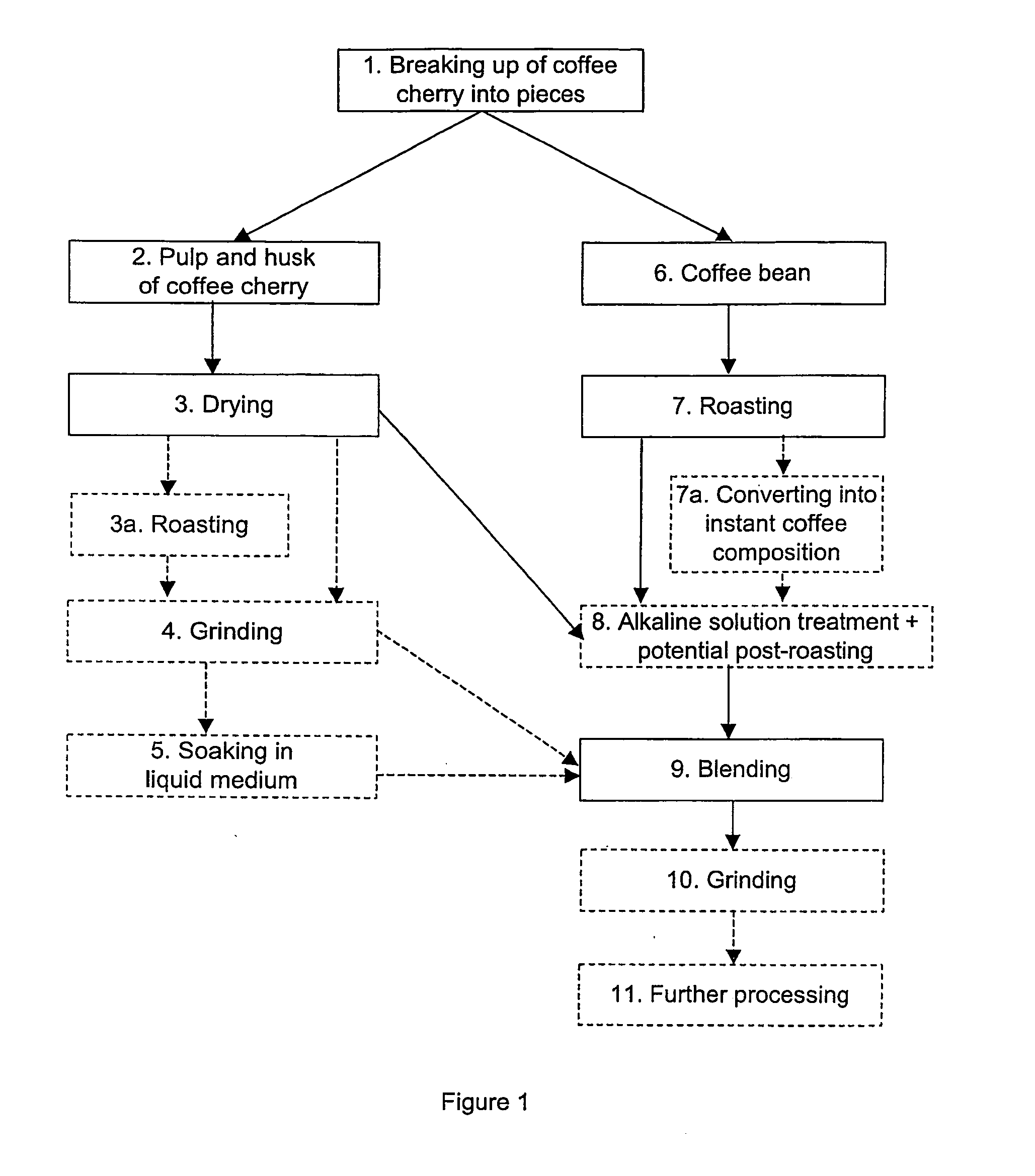Coffee Composition and Method of Making the Same
a technology of coffee and composition, applied in the field of coffee composition and a method of making the same, can solve the problems of increasing the production of coffee of average quality, increasing the production of high-quality coffee products, and increasing the cost of producing high-quality coffee products, so as to improve the preservability of coffee beans, improve taste characteristics, and preserve coffee longer
- Summary
- Abstract
- Description
- Claims
- Application Information
AI Technical Summary
Benefits of technology
Problems solved by technology
Method used
Image
Examples
example 1
[0066] 30 kg of Santos Brasil raw coffee was charged into a hot fluid-bed roaster. Coffee beans were roasted as surface roasting to a bean surface temperature of 218° C. The roasting was interrupted by water spraying lasting 15 seconds. After the beans had cooled to a temperature of 180 to 190° C., they were transported to an air cooling chamber where they were cooled to a temperature of 30 to 50° C. The cooled beans were placed into a mixing chamber, in which underpressure was produced, after which 900 g of sodium hydrogen carbonate solution (pH 8) was sprayed onto the coffee beans in the chamber, simultaneously stirring the coffee beans. The mixture was left to dry for 3 minutes, after which the beans were transferred to the roaster again. The surface temperature of the beans was raised to 210° C., after which the roasting was interrupted by a water spray of 10 seconds. The beans underwent deep roasting of 3 minutes, during which the alkaline solution evaporated. Then the coffee b...
example 2
[0068] Husk and pulp of Brazilian coffee cherries were separated from the beans by means of a depulping apparatus. The separation was carried out by a dry method using a depulping apparatus. After the husk and pulp of the coffee cherries had been separated from the beans, the pulp and husk obtained were dried by means of a warm-air blower at a temperature of 70° C. During the drying the material to be dried was turned from side to side. The drying was continued until the water content of the pulp and husk of the coffee cherry was about 14%. The product obtained was ground.
example 3
[0069] The coffee bean product roasted in accordance with Example 1 was treated with a solution containing pulp and husk of coffee cherries. Said solution was prepared by mixing water and dried and ground pulp and husk of the coffee cherry obtained in Example 2, whereby the dry solids content of said solution was about 10% by weight. The weight ratio of the coffee beans to the pulp and husk of the coffee cherry was 100:3. The coffee beans were treated in a vacuum mixing chamber, in which said solution was sprayed onto the coffee beans. The solution was allowed to be absorbed into the pores of the coffee beans, after which the beans were removed from the mixing vessel and were allowed to dry.
[0070] The modified taste characteristics of the coffee beans obtained were tested by grinding the beans and making a coffee beverage from the ground beans. The coffee beverage was made conventionally by extracting the ground coffee beans with boiling water. Test persons noticed the taste differ...
PUM
 Login to View More
Login to View More Abstract
Description
Claims
Application Information
 Login to View More
Login to View More - R&D
- Intellectual Property
- Life Sciences
- Materials
- Tech Scout
- Unparalleled Data Quality
- Higher Quality Content
- 60% Fewer Hallucinations
Browse by: Latest US Patents, China's latest patents, Technical Efficacy Thesaurus, Application Domain, Technology Topic, Popular Technical Reports.
© 2025 PatSnap. All rights reserved.Legal|Privacy policy|Modern Slavery Act Transparency Statement|Sitemap|About US| Contact US: help@patsnap.com

